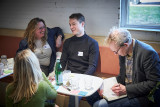Demo Day #20 : Upscaling ATELIER Buiksloterham

To mitigate climate changes and reduce CO2 emissions, the transition of the current energy system to a more sustainable and decentralized one is needed. In Amsterdam, the Buiksloterham demonstration project from ATELIER is paving the way for this transition. Buiksloterham is a Positive Energy District (PEDs) in practise, in which a local smart energy system and P2P trading governed by a citizen’s energy cooperation is implemented. The ambition of ATELIER/Amsterdam University of Applied Sciences is to research how to upscale and replicate this PED. For the Demo Day on the 16th of May, the Amsterdam University of Applied Sciences asked the Amsterdam Smart City network to discuss how we can learn from the Buiksloterham project to support replication and upscaling. Read through the most valuable outtakes from this session below.
What learnings to focus on?
Starting off, the participants pointed out that it would be most important to learn which choices have been made and why. Therefore, we need to keep track of these decisions and their outcomes. It was suggested to write down all the arguments for the choices made and create a matrix that shows what works or doesn’t work.
It would also be useful to make an impact assessment that shows how much CO2 and electricity is being saved a year. Another great source of information would be around collaboration, specifically with the network operator for example. How did the connection of the PED to the grid go and what learnings are to be gained from that collaboration wise?
Drivers for community involvement
Gathering the insights around community involvement would also be helpful. Danijela and Renée, from the Amsterdam University of Applied Sciences, explained how it has been difficult to get the community involved in the project. Based on the experience of the worksession participants, we concluded this is an issue in other local energy system projects as well. It would be great to investigate why this is the case and what the residents need/desire.
The participants suggest looking at the project from the (possible) resident’s point of view; Why would I want to live in a PED building? What’s in it for the residents?
There is a lot of focus on getting people on board with economic benefits, but is that actually what people want? This could also be connected to comprehensive wellbeing. What else can people benefit from by living in a PED and/or being involved in the community?
Local CO2 reduction vs national grid relief
The issue of getting people on board by promising lower energy costs brings up another question; Is this way of trading energy beneficial for the energy grid capacity? How would it work if we would all start trading energy?
A battery can be very useful for an energy community, for example. But batteries can actually put more load on the energy grid than needed and are therefore not always desirable when you look at it from the municipalities point of view. Local solutions for CO2 reduction and/or economic benefit could burden the national grid.
It is important to keep this in mind when creating the targets for a local energy system. In order to scale up the ATELIER project, it is therefore key to not only maximise economic value but also include other values. If the main focus is on creating economic benefit in order the gain the interest of the community, it is important to keep the effects on the national grid in mind.
New energy law
Finalizing the discussion, we shortly discussed the new energy law. This law says that you cannot own your own grid. Only the network operator can be the owner at the moment. This creates less flexibility and possibility since these network operators are obliged to provide a high certainty for the availability of electricity. The group suggested that the learnings from ATELIER might be helpful in influencing the change of this energy law. This would create more grid connection flexibility which would contribute to upscaling.
The discussion and collaboration around local energy systems and energy communities will be continued in the Amsterdam Smart City “Local energy systems” challenge. This article is written by Jessica van der Plas, former Programme Manager Energy & Circularity at Amsterdam Smart City.
From mid-june 2023, Noor Veenhoven joined the team as our new Programme Manager Energy & Circular. Want to know more about the local energy systems challenge? Reach out to Noor via noor@amsterdamsmartcity.com or leave a comment below!



